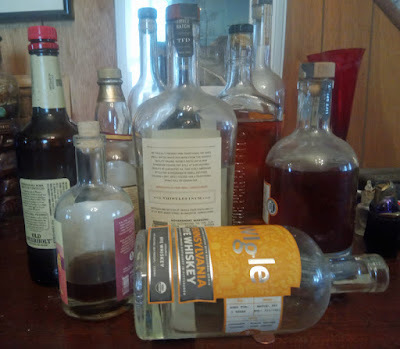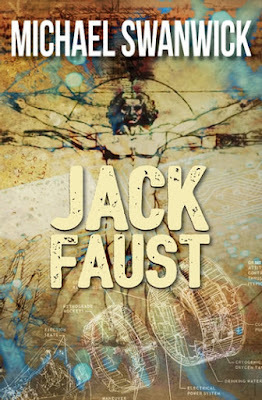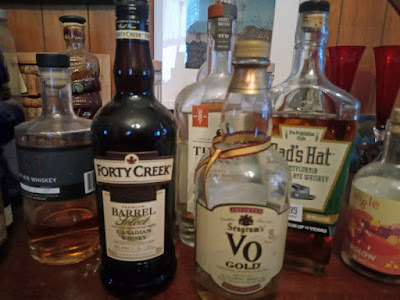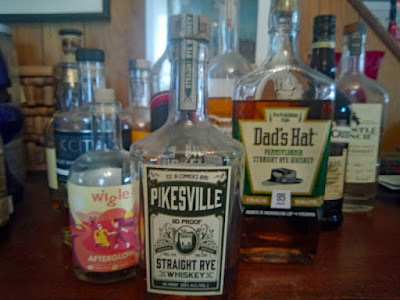Michael Swanwick's Blog, page 41
April 10, 2022
An Answer Without a Question
.
Today, I went to a Lyric Fest concert featuring the world premiere of ten art songs. Marianne and I arrived early, to find a question and answer session with the composers going on.
As we reached our seats, one of the composers said, "I used to have a different answer to that question. But this year I had an extreme health event. Now all I want to do is make music in the company of people I love."
Which is such a perfect answer that I don't give a damn what the question was.
*
April 9, 2022
The Night Bell
April 5, 2022
The Once and Future Rye, Part 8: The Disaster of Prohibition
.

Chapter 8: The Disaster of Prohibition
If Libertarianism has an Exhibit A, it has to be Prohibition. Prohibitionists had the very best of intentions. There is no denying that alcohol is responsible for a great deal of violence, crime, domestic abuse, fatal accidents and other ills. But rather than creating a kinder, gentler, and (given the motivations of most “drys” it has to be acknowledged) more Christian nation, Prohibition supercharged the growth of organized crime, corrupted police departments from coast to coast, and promoted a widespread cynicism about the American political system that has yet to subside. Also, ironically enough, drunkenness, both public and private, soared.
It is collective wisdom that during Prohibition, Americans made do with moonshine and bathtub gin, and so they did—if they were poor. A handful of distilleries were given special dispensation to produce alcohol for non-recreational purposes. The middle-class could drop by the pharmacy on the way home to buy a bottle of whiskey clearly marked FOR MEDICINAL PURPOSES ONLY. Those with money and connections bought cases of smuggled rum or tequila if they were near the southern border or Canadian whisky if they were near the northern border.
For fourteen years, Canadian whisky, silky-smooth and not at all spicy, was the best you could buy. American palates adjusted themselves accordingly.
Then prohibition ended and the distilleries reopened—those that could afford to wait several years for their product to age sufficiently to compete with businesses in Montreal and Kilmarnock.
The long-term effect of the Great Experiment on rye whiskey can be shown in parvu in the history of Old Overholt, the oldest continually-made American whiskey. The business was begun by Abraham Overholt who in 1810 began distilling rye on his family farm. Over the next century, it became the nation’s leading name in whiskey. When other distilleries were closing, it had the good fortune to receive a license to produce “medicinal whiskey” from the Secretary of State—none other than Andrew Mellon, a part-owner of the company. Things were looking good.
Repeal, however, was not kind to Old Overholt. Sales dwindled. The company was sold to Jim Beam in the 1950s and production moved from place to place before finally settling in Kentucky. The original mash bill did not go with it. The bottled in bond 100 proof manly bottle of rye became a low octane, high corn Kentucky style rye that was produced only a couple of days a year and routinely sold from the bottom shelf. By 1970, it was the only nationally-distributed rye in existence.
This does not necessarily mean you should rush out and become a libertarian. But those who already are have every right to say “I told you so.” Because they absolutely would have if they’d been around a hundred years ago.
To mourn the near-demise of rye whiskey and the part that politics played in it requires a pre-Prohibition cocktail like the Ward 8:
Ward 8
2 ounces rye whiskey
½ ounce lemon juice
½ ounce orange juice
3 teaspoons grenadine
2 or 3 speared cherries or a slice of orange
directions: mix, chill, and garnish with cherries, orange slice, or both
The Ward 8 was created in honor of a political boss in a Gilded Age bar in Boston’s Eighth Ward, and is basically a variant of the whiskey sour. Originally the cherries were speared by a small paper Massachusetts flag, but that’s obviously not required.
This is a solid drink, fruity without being sweet, whose flavor is sufficiently emphatic to cut through the miasma of cigar smoke and corruption in which it was born. An excellent way to celebrate the victories of your favorite if flawed politico.
So Prohibition was over and King Rye was all but dead. It was time for another whiskey to take up the crown.
*
@font-face {font-family:"Cambria Math"; panose-1:2 4 5 3 5 4 6 3 2 4; mso-font-charset:0; mso-generic-font-family:roman; mso-font-pitch:variable; mso-font-signature:-536870145 1107305727 0 0 415 0;}p.MsoNormal, li.MsoNormal, div.MsoNormal {mso-style-unhide:no; mso-style-qformat:yes; mso-style-parent:""; margin:0in; mso-pagination:none; mso-layout-grid-align:none; text-autospace:none; font-size:12.0pt; font-family:"Times New Roman",serif; mso-fareast-font-family:"Times New Roman";}.MsoChpDefault {mso-style-type:export-only; mso-default-props:yes; font-size:10.0pt; mso-ansi-font-size:10.0pt; mso-bidi-font-size:10.0pt;}.MsoPapDefault {mso-style-type:export-only;}div.WordSection1 {page:WordSection1;}
April 3, 2022
Short Fiction Review: "Thoughts and Prayers" by Brenda Peynado
.

A friend recommended I buy Brenda Peynado’scollection of fiction, The Rock Eaters, pointing out that, while comfortably genre, most of the stories were published in literary magazines like the Georgia Review and the Kenyon Review Online.I did and, yes, these works exist in the space not many writers occupy where the mingled fabulism of fantasy-SF-horror coexists with the mainstream.
The lead story, “Thoughts and Prayers,” begins as follows:
The morning before the school shooting passed like any other, all. My neighbors out at dawn performing oblations to the angels on our roofs. Families clustered around the sidewalks, mist from our lawns swirling around our ankles, looking up at the angels’ pale humanoid faces and downy bird bodies perched beside our chimneys. Our mothers beat their breasts, performing sorrow for the tragedies that always went on elsewhere in the world. Our parents shouted their usual “Thoughts and prayers! Thoughts and prayers!” toward the angels atop our roofs .As children, we were supposed to kneel in the moist grass and be quiet, in case the angels were ever to speak.
Which is not only beautifully written but efficient storytelling.
Though the angels supposedly protect the families within their chosen houses, some angels are better at it than others. The results are indistinguishable from chance. People being people, those who experience a run of bad luck are assumed to somehow deserve their defective angel.
The narrator/protagonist lives through the shooting but the sister of a close friend does not. Those affected react in the complex ways that a community in trauma might. It’s convincingly done, in part because Peynado is a dab hand at creating thoroughly believable characters.
I have only one dissatisfaction with the story. The day after the shooting, the Mothers for the Sanctity of the World and the Good Guys With Guns show up to feed off of the ensuing
media attention. The women are sanctimonious, the men with their AR-15s are a constant danger to the children, and the story veers off into outright satire.
But that may just be me. A lot of readers like satire and prefer that its messages come across loud and clear. Buy a copy (or get it through your library) and make up your own mind.
In any case, there’s no denying that Brenda Peynado is a heck of a good writer. I’m glad I bought that book.
*
March 30, 2022
April Fool's Day Sale --Jack Faust!
.

On April 1--no fooling!--the ebook of Jack Faust, my radical revision of the Faust legend as embodying half a millennium of human history, goes on sale for only $1.99. United States only, alas. So if you're in the US, curious about my novel, and like ebooks... well, here's your chance.
That's this Friday--tomorrow!
Below is the information they've given me.
You can subscribe to the newsletters at the links below so that you will get the direct link to the deal on the day that it appears.
Newsletter Link Early Bird Books Subscribe Now The Lineup Subscribe Now The Portalist Subscribe Now Murder & Mayhem Subscribe Now A Love So True Subscribe Now The Archive Subscribe Now The Reader Subscribe Now
*
March 29, 2022
The Once and Future Rye, Part 7: Why Canadian Whiskey is Stranger Than You Think
.

Chapter 7: Why Canadian Whisky is Stranger Than You Think
There is more that is strange about Canadian Whiskythan the fact that they spell it in the Scottish manner. In the United States, for a whiskey to be labeled “rye,” the mash bill must be at least 51 percent rye. Canada takes a more laissez-faire approach. If Canadian whisky had a motto it might well be Blend What Thou Wilt Shall Be the Whole of the Law. So a Canadian rye may well be primarily corn or wheat whisky with a smaller amount of rye for flavoring.
But wait, it gets worse.
It is a peculiar but observable phenomenon that food gets spicier the closer one gets to the equator and blander the closer one gets to the poles. Similarly, Canadians prefer their whiskey smoother and lighter than their neighbors to the south. As a result, most Canadian Whisky is a blend of several grains, carefully chosen to result in a smooth, light drink. But that doesn’t mean that Canadians don’t like the flavor of rye! When distillers started adding small amounts of rye to the mash bill, the demand for rye-flavored whiskies was so great that Canadians started referring to all whiskies as “ryes.”
So it is possible in Canada to be served a glass of rye whisky that has absolutely no rye in it at all.
Nevertheless, Canadian whisky is traditionally both smooth and complex. For a long time, Canadian whiskies were the embodiment of what the sophisticated drinker wanted. And because Canadians valued the pop of rye in their blended whisky, the big distilleries in Indiana kept making it. Thus helping keep the craft of distilling rye whiskey alive at a time when it was in danger of going extinct.
To celebrate Canadian whisky, the American Martini Laboratory mixed two Toronto Cocktails, one with Canadian whisky and one with rye whiskey and did a taste test:
Toronto
2 ounces Canadian whisky or rye whiskey
½ ounce Fernet-Branca
½ tablespoon simple syrup or pure maple syrup
2 dashes Angostura bitters
orange peel
directions: mix, add ice and garnish, serve
Like our neighbors to the north, the Toronto is verycomplicated. The Fernet Branca is a particularly bitter aromatic spirit, originally sold as a cure for cholera and for menstrual cramps. The maple syrup (you can use simple syrup, but why give up that added tinge of flavor?) alleviates the bitterness without turning this into a sweet drink. The rye, either Canadian or Not, gives it oomph. This is a cocktail for grownups—it is a rare college freshman who will take to it.
And the taste test? The American Martini Laboratory’s blue-ribbon panel of two agreed unanimously that the cocktail tasted better with American rye. Canadians, however, would probably disagree.
Before Prohibition, the fact that Canadian ryes need not include rye was a mere curiosity. After that great disaster, it would be decisive in changing the taste of the United States.
*
March 24, 2022
A Small But Pleasant Honor
.

The Portalist included my novel Bones of the Earth in their list of best science fiction of the first decade of this century. Naturally, I'm chuffed. Those novels on the list that I've read (most of them) are books you'd be honored to have your own compared to.
You can find the link here.
This kind of list is clickbait, of course, and an invitation to argue about what should have been included.
So, what the heck... which SF novels published in the years 2000 to 2010 SHOULD have been included? Feel free to be effusive in your praise.
*
...And I Was Wrong
.
A couple of days ago, I regretted that James Branch Cabell didn't share in print a formula he claimed to have:
"When next I see you I shall submit a simple formula by which you can do a 2,000 word preface without the least mental stress."
Well, a few pages later in The Letters of James Branch Cabell, he wrote:
There are just four points, I think, to be covered always: the place and the significance of the book in your complete work; [...] your own personal view of the book nowadays, as well as, if you like, of the dead person who wrote it; the book's origin and the circumstances in which it was written; and how, and when, and what happened after, the book was published--which of course gives you a free hand with the reviews and the acquaintances you may have made through it.
So I was wrong. Cabell did write down the formula and, while potentially useful, it is not nearly as interesting as I'd hoped it would be.
Ah, well. It's not the first time I was wrong nor, I suspect, will it be the last.
*
March 23, 2022
The Once and Future Rye, Part 6: The Elegance of Maryland Rye
.

Chapter 6: The Elegance of Maryland Rye
Even today, Monongahela is the most prestigious variant of rye whiskey. But from early on, it had a worthy rival—Maryland Rye.
What made Maryland rye distinctive? Well… It might have been the terroir. It might have been the quality of the limestone-filtered water. But most likely it was the presence of corn in its mash bill. This resulted in a milder, smoother, and less spicy rye. Which proved to be a respectable alternative to its Pennsylvania cousin.
Just as Monongahela rye went extinct in Pennsylvania, so too did Maryland rye in the Old Line State. One by one, the distilleries shut down. Pikesville Rye, the last to go, is now made in Kentucky. There is currently a revival of the style by several new Maryland distilleries. How close their formulations are to the original to the original, no one knows. But as a general rule, the stuff from Pennsylvania is spicier and the stuff from Maryland is smoother.
If you’re wondering which is better, you’re asking the wrong question. The real question is: What are you looking for in a drink? Some like it smooth, others spicy. In this way, choosing a rye is like selecting a mate. Suave or rowdy? The choice is yours.
To get a good idea of just how suave a Maryland rye can be, there is no better cocktail than an old Baltimore classic, the Belvedere Frozen Rye.
Belvedere Frozen Rye
rye whiskey
juice of half a lime
a few dashes orange juice
a few dashes pineapple syrupa few dashes orange Curacao
slice of orange
slice of pineapple
directions: place slices of orange and pineapple in a champagne coupe, allowing them to stick out as garnish; fill glass with fine ice; mix ingredients and pour over the ice
This is a sweet, festive and utterly delightful drink. But there’s no denying that it’s a lot of fuss to make at home, particularly since the recipe is vague about the proportions of rye and juices. The best way to enjoy a Frozen Rye is in one of the few bars that are still classy enough to serve it. The Belvedere Hotel, where it was invented, has been converted to condominiums, but the Owl Bar remains and it did a bang-up job of the drink the one time I was there.
*
@font-face {font-family:"Cambria Math"; panose-1:2 4 5 3 5 4 6 3 2 4; mso-font-charset:0; mso-generic-font-family:roman; mso-font-pitch:variable; mso-font-signature:-536870145 1107305727 0 0 415 0;}p.MsoNormal, li.MsoNormal, div.MsoNormal {mso-style-unhide:no; mso-style-qformat:yes; mso-style-parent:""; margin:0in; mso-pagination:none; mso-layout-grid-align:none; text-autospace:none; font-size:12.0pt; font-family:"Times New Roman",serif; mso-fareast-font-family:"Times New Roman";}.MsoChpDefault {mso-style-type:export-only; mso-default-props:yes; font-family:"Calibri",sans-serif; mso-ascii-font-family:Calibri; mso-ascii-theme-font:minor-latin; mso-fareast-font-family:Calibri; mso-fareast-theme-font:minor-latin; mso-hansi-font-family:Calibri; mso-hansi-theme-font:minor-latin; mso-bidi-font-family:"Times New Roman"; mso-bidi-theme-font:minor-bidi;}div.WordSection1 {page:WordSection1;}
March 22, 2022
A Question for the Hive Mind
When I was single digits years old, I discovered that my next-door neighbor and first girlfriend Susan Richards (who later beat me into print by years with Hubert, the Caterpillar Who Thought He Was a Mustache) read more than one book at once.
Back then, I read one book at a time. I asked my mother what was correct and she firmly told me to finish each book before reading the next.
Who was correct? Mom or Susie? And does that answer apply to my adult reading?
I solicit your input. Answers that simply state your preference without explaining why will be deleted. It's your reasoning that I'm most interested in.
*
Michael Swanwick's Blog
- Michael Swanwick's profile
- 546 followers




